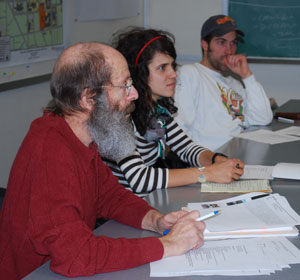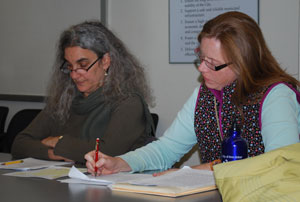Meeting Watch: Public Market (30 Oct 2008)
A mixup over which group had reserved the council chambers on Thursday night led to the Public Market Advisory Commission holding most of its meeting off-camera. That glitch might have inadvertently foreshadowed a broader move by the city, which is considering whether to curb the cable-access broadcast of some public commissions – something that the public market commissioners hope doesn’t happen.
Market history: Thursday’s meeting began with a slide show by commissioner and landscape architect Peter Pollack, who described how the farmers market and the Kerrytown area around it have changed over the years.
Many of the major changes since the early 1980s – including street lighting and the bricking of Detroit and Fourth – have been funded with help from the Downtown Development Authority. At times there were more social spaces for shoppers, including wooden park benches near the market. Pollack also showed a slide of when large ash trees towered over the market, and another one after they’d been removed following destruction by the emerald ash borer. And he noted that trees are selected for installation around the area for specific reasons. The Bradford pear trees, for example, were picked in part because they flower in the spring, visually signaling the start of the growing season.
Pollack also included slides of markets in Toronto and Seattle. These markets provided examples of things the Ann Arbor market might want to consider, such as themed activities on certain days of the week, more visible signs promoting the market, and large portable tents that could give the market more flexible space.
As Pollack was wrapping up around 6:30 p.m., a man came in and told the commission that he had reserved the room for a meeting of about 40 election inspectors. Since that group was much larger than the market commission – which included four commissioners and market manager Molly Notarianni – they decided to relocate to a small conference room on the fourth floor. (Notarianni later asked Pollack if he could provide the slides to be posted on the market’s website, and he agreed.)
Seniority rules: When the commission reconvened in its new location, the next major item on the agenda concerned seniority rules for market vendors, which had been much discussed at previous meetings. Based on the feedback they’d gotten and discussions they’d had, Pollack proposed extending the current system for another year. Notarianni suggested that they postpone a vote on this topic until next month’s meeting, because they were currently not being televised (only the council chambers is set up with CTN cameras) and next month they would be. The commissioners agreed. Pollack said that would also allow them to write up a resolution and post it in advance of the meeting.

Commissioner Peter Pollack, market manager Molly Notarianni, and commissioner Shannon Brines at the Oct. 30 Public Market Advisory Commission meeting.
Operating rules: Pollack updated the commission on a review of the market’s operating rules. Some are being tweaked in small ways, he said. One example he cited is clarifying a vendor’s relationship to products grown on leased land. Ultimately, the commission will make a recommendation to city staff for possible changes.
Invasive species at the market: Pollack reported that a market-goer had notified the commission about a vendor who was selling invasive plants – specifically, Asian bittersweet (Celastrus orbiculatus). He noted that the city has an invasive species list and that of course they shouldn’t be for sale at the market. He suggested adding it to the update of operating rules.
Meeting location during upcoming city hall construction: Notarianni reported that while it’s not yet clear where meetings will be held during the project to rebuild city hall, it looks like the city plans to scale back on the number of public meetings that will be televised on CTN. That means, perhaps, that only the larger groups – like city council, the planning commission, the park advisory commission – will be broadcast. Notarianni said she would continue to advocate for airing the market commission, a strategy that was supported by commissioners. Pollack said that if they are cut from CTN’s lineup, they need to make sure to hold meetings in an easily accessible venue, and possibly videotape them independently.
Market manager’s report: Notarianni updated the group on several initiatives. She said the market’s website has started highlighting local restaurants that support local growers. Also, the market is nearly ready to begin accepting Michigan Bridge cards (formerly known as food stamps), which The Chronicle has previously reported. She’s working with the Community Action Network on possible projects, like offering cooking and nutrition classes or helping transport people to the market. CAN provides support to people living in local public housing projects.
Finally, responding to queries from the commissioners, Notarianni established that she ate and drank very well at the recent Slow Food biennial conference in Turin, which commissioner Shannon Brines also attended (he described the logistics of the event as “very Italian”). She’ll be making a more detailed presentation about that event at next month’s meeting.
Report on joint working session with the Greenbelt Advisory Commission: Just prior to the market commission meeting, Pollack and Notarianni attended a joint session with some members of the Greenbelt Advisory Commission to talk about ways they could collaborate. Pollack said that since he and GAC member Sylvia Taylor are also on the county’s Natural Areas Technical Advisory Committee, three groups were represented. Several ideas were discussed, Pollack said, including the possibility of starting a farm incubator program on land that’s either part of the greenbelt or the county’s natural areas preservation program. Pollack said the groups expect to have similar joint meetings in the future.
Local food summit: Brines, who was soldiering through the meeting despite his serious head cold, reported that on the heels of September’s Homegrown Fest, which he helped organize, there’s a group that’s planning a local food summit. They hope to hold it early next year at Matthaei Botanical Garden and bring together local farmers, chefs, gardening groups, schools, government officials – really, anyone and everyone who’s interested in supporting a local food network. No date has yet been set, but it will likely be a weekday, Brines said. He operates Brines Farm in Dexter and is a vendor at the farmers market.
Homework for next meeting: Pollack asked all commissioners to brainstorm ideas for 2009, so that they can begin to prioritize what they’d like to see at the market next year. Ideas tossed out at the meeting included having a month-long themed series of events, and holding special events like pumpkin carving near Halloween or storytelling sessions during market hours.
Present: Diane Black, Genia Service, Peter Pollack, Shannon Brines. Absent: Ken King
Next meeting: Nov. 20 at 6 p.m. in the 2nd floor council chambers, Guy C. Larcom, Jr. Municipal Building, 100 N. Fifth Ave.






Our thanks to Steve Bean, chair of the Ann Arbor Environmental Commission, who passed along this list of new meeting locations starting in January 2009 through spring 2011. The changes affect boards or commissions that typically meet before 7 p.m. in council chambers:
Building Board of Appeals, County Building at 200 N. Main, lower level conference
Commission on Disability Issues, Community Television Network, 2805 S. Industrial
Energy Commission, County Board of Commission Public Meeting Room
Greenbelt Advisory Commission, County Board of Commission Public Meeting Room
Housing Board of Appeals, County Board of Commission Public Meeting Room
Park Advisory Commission, County Board of Commission Public Meeting Room
Public Market Advisory Commission, County Building at 200 N. Main, lower level conference room.
Sign Board of Appeals, County Building at 200 N. Main, lower level conference